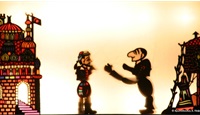
Applicants:
(a) Association "Friends of the Shadow Theater of Cyprus" [Christodoulos Andoniou Paphios and collaborators].
(b) Shadow Theatre Group Giannis Paphios
(c) Museum - Paphios School of Shadow Theater [Christos Achilleos Papihos and collaboratos].
Communities Concerned - Bearers of the element:
Shadow theater groups and collaborators, museums, associations and workshops, such as:
(a) Association "Friends of the Shadow Theater of Cyprus" [Christodoulos Andoniou Paphios and collaborators].
(b) Shadow Theatre Group Giannis Paphios
(c) Museum - Paphios School of Shadow Theater [Christos Achilleos Papihos and collaboratos].
Domain of Intangible Cultural Heritage:
Oral traditions
Performing arts
Social practices, rituals and festive events
Traditional craftsmanship
Date of inscription:
2016
Geographical distribution:
The art of Karagiozis, the most popular form of shadow theatre in Cyprus, made its first appearance on the island in the early 20th century, through Greek shadow puppeteers (karagiozopaiktes) who would come to the island to perform shows, and from Cypriots who learned their craft from puppeteers in Greece. Today, the few remaining karagiozopaiktes are to be found in the Paphos, Limassol, Nicosia and Larnaca districts.
Brief description:
The first karagiozopaiktes would perform in coffee shops, inns and open spaces such as village squares and school yards. Children and adults would watch and be entertained by the plot of the shadow play, and would either pay a fixed fee or contribute whatever they wished to - or were able to give. Today the karagiozopaiktes continue this tradition, and perform in festivals and fetes, as well as in schools and various cultural events. Through their performances and teaching activities, they aim to pass on the art to the new generation, in order for this popular art form to continue.
The subjects of the plays are largely drawn from ancient Greek mythology, the Scriptures (Old and New Testament), Greek and world history, world literature, popular legends and traditions, local history, news and events. In older times, because karagiozopaiktes would set up their stage at a coffee shop or a similar establishment for a set amount of time - and they wanted to attract an audience for the following evenings too, they would present many of their plays in episodes. Most Cypriot karagiozopaiktes would bring and perform published works from Greece or purchase the scripts from bookstores in Cyprus.
A karagiozopaiktis must have his or her own workshop to make the cardboard or wood puppet figures, the props and set designs, and have the knowledge and skills to create them and perform a show. The skills needed include designing, painting, carving and cutting the puppets, writing, acting, improvising and directing skills, correct articulation and enunciation, musical talent to perform songs, and good communication skills.
The shadow theatre plays are presented on a white, tightly stretched screen, lit from behind by a bright light. In older times karagiozopaiktes would use acetylene, oil lamps and paraffin lamps to light up the screen, whereas today they actually use electric lamps. Besides singing songs during their plays, karagiozopaiktes would also provide the appropriate sound effects by clapping or slapping their hands and using instruments and sound-making objects, such as reeds, bells and tins. Nowadays, recorded music and sound effects are also used.
The puppet figures were initially made from hard condensed cardboard, which karagiozopaiktes would cut out after drawing the outline. In rare cases, they would also use animal skin. The various decorative elements were added at a later stage. In order to highlight the various characteristics of the figures, such as the eyes, karagiozopaiktes would also carve the figures. But as the figures would fray, the shadow theatre masters would paint them with one or more layers of wood glue. Christodoulos Antoniades Pafios would make his own glue, by mixing powder with water. And by painting the figures, the karagiozopaiktes became folk artists too. Nowadays, the figures are made mainly from coloured transparent plastic, which showcases their colours with more vibrancy and they represent various heroes, such as:
Karagiozis: The model of the rascal, intelligent, scandalous, poor and hungry Greek man. Always cheerful and willing to get involved in anything. He almost always ends up being beaten up.
Aglaia: Karagiozis’ wife. She represents the character of the impoverished, bedraggled Greek housewife, who is always trying to help her family.
Kollitiria: Karagiozis’ three children - Kollitiris, Myrikongos and Kopritis, are always hungry but crafty enough to ensure they always manage to find food.
Hadjiavatis: Karagiozis’ friend and the Pasha’s town crier, who always ends up being wrapped up in Karagiozis' schemes.
Omorfonios: Omorfonios, meaning the pretty boy, is ugly; with a huge head and big nose. He is of the impression that he is handsome and mocks other ugly people. He satirises the so-called successful people of each era. When he faces trouble, he runs to his mummy.
Sior Dionysios: A civilized and dignified fallen aristocrat, he wears a top hat and tails and speaks with a Zakynthian accent.
Pasha: He represents the Turkish authority and the power. Dressed as a rich commander, he expresses his formality with his sombre, strict style.
Vezyropoula: Pasha’s daughter. A young spoilt girl accustomed to the easy life - she seems to respect and obey her father. Due to her cunningness she always manages to get what she wants.
Megas Alexandros: The King of Macedonia, Alexander the Great, symbolises the intrepidity and strength of the Greek nation. According to tradition, in the shadow theatre he also symbolises Saint George, who kills the snake and liberates the country from suffering.
Thirio: the cursed Ophis. He symbolises all the suffering and evils of the world.